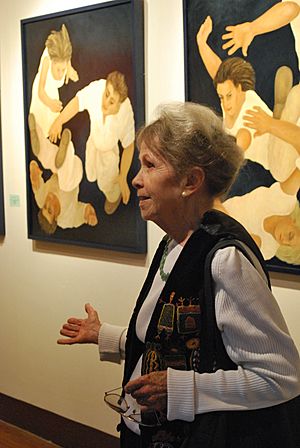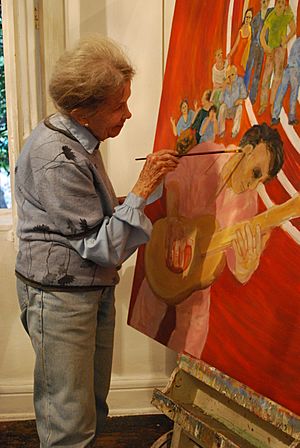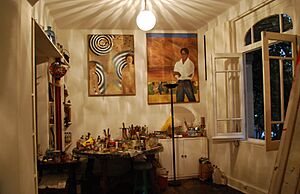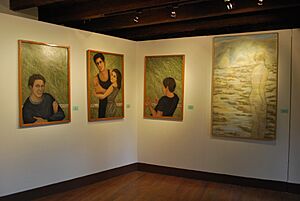Helen Bickham facts for kids

Helen Bickham is a talented Mexican artist. She was born in Harbin, China, but moved to the United States during World War II. After living in Europe for a while, she settled in Mexico in 1962. Helen started drawing at age six, but she didn't become a professional artist until 1975. Since then, she has had 70 solo art shows and been part of over 300 group exhibitions. She has also been a member of the important Salón de la Plástica Mexicana since 1997. Her art often shows people in landscapes. It aims to share feelings or moods, rather than just showing a person or object exactly as they look.
Helen Bickham's Life Story
Helen Bickham was born on June 9, 1935, in Harbin, Manchuria. At that time, the area was under Japanese control. Her mother, Nadezna Ivanofnof Rachoak, had a mixed Ukrainian and Asian background. Helen's father, Howard Montgomery, was an American Navy officer. He sadly passed away during World War II when Helen was only eight years old. Before his death, Helen and her mother moved from China to the United States. They arrived just before the attack on Pearl Harbor.
Helen grew up as an only child in different parts of the United States. It was hard for her and her mother to get used to life there. Her mother didn't speak English well and worked jobs like sewing and cleaning houses. She mostly spent time with other people from Europe and Asia who spoke Russian. Helen was often alone as a child. She spent most of her time reading and drawing because her mother had to work so much.
Being caught between different cultures made Helen feel like a quiet observer. She started drawing what she saw when she was just six years old. She remembers other children asking her to draw things for them. Sometimes, she would draw figures without clothes, like paper dolls, to add them later. This once caused a mother to call her "degenerate." Her own mother didn't encourage her art. However, Helen did get some support for her art at school. In elementary school, she was often allowed to leave class to draw murals in the hall. These murals, usually about themes like Thanksgiving, were drawn on large butcher paper.
Helen was a curious child and young adult. She often questioned the answers given by her family and religion. Even though her mother and stepfather didn't think university was right for girls, Helen went to the University of California, Berkeley. She went on a scholarship. She took classes that were known to be the hardest, in many different subjects. This was because the university let students create their own main study areas. She chose American civilization because she was an immigrant. She wanted to understand the ideas that European settlers brought to America. She didn't major in art, but she took an art appreciation class.
For this class, she had to create a watercolor painting. Helen wanted to make her image perfect. Her professor noticed this and said she was an artist. She also had to visit a museum in San Francisco. At first, she didn't want to go. But after seeing a real Édouard Manet painting, not just a copy, she was amazed. She went home happy to show her ticket stub to her professor. She got married in the late 1950s and had her first son, Geoffrey, before her family moved to Europe.
When Helen lived in Florence, Italy, her landlady was a painter. Helen also got to see many famous artworks in person. She spent a lot of her time in Europe visiting museums in Italy, France, Germany, the Netherlands, and Belgium. She later returned to the United States, where her second son, Brett, was born. She lived near Indianapolis, painting landscapes and still lifes. During this time, she met painter Bill Majors. He saw Helen's watercolors and said she painted them like oil paintings. He then bought her a set of oil paints. In 1962, Helen went to Mexico for a six-week vacation. While she was away, a friend entered three of Helen's paintings in an art competition. All three of them won prizes!
Helen says she instantly fell in love with Mexico and decided to stay there permanently. She wanted her sons to experience a bicultural life. Except for some trips to the United States and Europe, Mexico has been her home ever since. When she decided to live in Mexico, she was a single parent. One of her children was sick and needed full-time care. She wasn't a rich foreigner. Instead, she worked by teaching English. She first lived in a small, quiet town called San Lorenzo Acopilco, west of Mexico City. It was a poor area, but she needed the peace it offered. She then moved to Mexico City for her son's medical care. She became an English teacher at schools like Garside and the Instituto Politecnico Nacional. During these years, she kept painting. Her focus changed from landscapes to people, as she was very impressed by the people she met in Mexico.
For much of her life, Helen didn't think about becoming a professional painter. It was a hobby and a passion, a way to show her inner feelings. From 1962 to 1975, she was busy teaching English and raising her children. Because she had a small budget, she went to art exhibition openings in her free time. She met many artists there. After seeing her so often, they started inviting her to their homes. She stopped teaching English at the Instituto Politécnico Nacional when they wouldn't let her take a year off to take her children to Europe. In England, she represented Mexico. She presented a letter from a famous art curator, Fernando Gamboa, to the Mexican embassy. She was then officially invited to show her art in England as a Mexican artist. She continued to have successful shows. Since returning to Mexico, she has been a full-time painter.
Today, Helen Bickham lives in the Colonia Roma neighborhood in Mexico City. Her apartment has big windows that face the Plaza de las Cibeles fountain. This gives her lots of natural light. Her paintings cover most of the walls, except for her bedroom. She found herself taking paintings down at night to fix them! She paints every morning after waking up. She paints either by a window in her apartment or on the building's roof, often with coffee. She looks delicate, but her eyes are described as "laughing." She often rides her bicycle around Mexico City. Helen says she has two great loves: people and nature. People and places that impress her can stay in her memory for years. She has traveled much of the world. She believes that there are universal feelings that make us human. She also believes a world where people from different cultures live in peace is possible. She is very connected to Mexico. She says its people have a "real humanity" about them. They can smile and be polite even when times are tough. This has influenced her art. There was even an entire exhibition at UNAM called "México a través del pincel de Helen Bickham" (Mexico through the brush of Helen Bickham). This show highlighted her impressions of Mexico.
Helen Bickham's Art Career
Helen Bickham's first art show was in 1963. However, she considers her professional career to have truly started in 1975. That's when she began painting full-time. Since then, she has had 70 solo exhibitions. She has also taken part in over 300 group shows. Her art has been displayed in Mexican cities like Mexico City, Monterrey, Acapulco, and Puerto Vallarta. It has also been shown in the United States, England, Scotland, Switzerland, Argentina, and Canada.
Some of her most important exhibitions include those at:
- The Arts Association of the State of Indiana (1963)
- Galería May Brooks in Mexico City (1965)
- Foreign Friends in Acapulco (1970)
- Thomoas V. Robinson Galleries in Houston, Texas (1978)
- Pacific Design Center in Los Angeles (1980)
- Hotel Ritz-Carlton, Boston (1982)
- Howard Coron Collection in New York (1985)
- Zum Blauen Gallery in Winterthur, Switzerland (1989)
- Galería de Arte Misrachi in Mexico City (1995)
- Universidad Autónoma Metropolitana Casa de la Primera Impresora in Mexico City (1996)
- Museo de la Ciudad de Querétaro in Querétaro (2003)
- Museo Ex Convento del Carmen in Guadalajara (2006)
- Galería Hecaro in Mexico City (2007)
- The Forum in Xalapa (2010)
Some of her well-known artworks include En el Jardín del Desierto, En su Mente, Hacia el Abismo, Llegando al Fin del Día, Cuatro Puntos, and a series called Cacería en el Norte.
In the 1960s, Helen was featured in a University of Texas book about modern Mexican art. She became a member of the important Salón de la Plástica Mexicana in 1997. She currently serves on its board.
Helen Bickham's Art Style
Helen Bickham has worked with many different art materials. These include watercolor, oil paint, pencil, ink, lithography, engraving, and paper embossing. She prefers to work on medium to large-sized canvases, fiberboard, and museum board. She has also tried mixing different materials. For example, she combines drawings with washes of color. She also mixes painting and drawing with embossing, like in her piece Palomas. In this artwork, doves are raised from the paper, flying away from the hands of a woman. Helen starts, erases, and moves images around her canvas until she is happy. She thinks all her artworks are still being made as long as she owns them. This is why she doesn't put dates on her work.
Her art has always focused on everyday people. She bases her figures on those she sees in daily life. She feels these people are more open about their feelings. Her work shows figures, but they are not like photographs. She prefers to capture a feeling rather than an exact person. Her earlier works in Mexico often showed typical Mexican scenes. These included street musicians, women working, men collecting trash, and people in traditional Mexican markets like La Merced. Later, the people in her art became more general Westerners, but the landscapes behind them often remained Mexican. Her art has been compared to that of famous artists like Diego Rivera, Rafael Coronel, and Marysole Wörner Baz.
The main goal of her art is not just to show people or landscapes. It's about looking inward and thinking deeply. The people in her artworks are made-up figures. They appear in the front, with one or two landscapes in the background. The people might be a single man or woman, a pair, or a small group. They are shown working, playing, or just existing in nature. The settings are normal, but often the expressions or body language show some kind of tension. Helen says her goal is to show the inner feelings people have during everyday activities. She describes her art as a "window on an instant."
For example, in En el Jardin del Desierto (In the Garden of the Desert), a man and woman stand next to each other. But they are separated by the large, spiky leaves of a maguey plant. This shows they can't connect. Often, like in this painting, the people in her art look at the viewer. It's as if they want to start a conversation. Her work tells a story, even if the story isn't always clear. Her art usually explores relationships, feeling alone, thinking deeply, and adjusting to new things. She says many of her paintings aim to show a journey, either physical or spiritual. This represents personal growth.
Helen gets her ideas from watching people. She might be struck by a look or movement that she feels everyone can relate to. She has found this inspiration in different parts of Mexico, as well as Scotland and New York. Her paintings show her ideas about life, based on her travels and experiences. She draws expressions that can be understood by anyone, no matter their culture. "Human emotion crosses every frontier in the world," Helen Bickham said. "The human condition interests me. We all have such a hard time of it."
As human relationships change, she has experimented with diptychs (two-part paintings) and even triptychs (three-part paintings). She paints the pieces so they can be rearranged and still fit together, but in a different way.
She has created some artworks in response to world events. These include the Bosnian War, the uprising in Chiapas, and the murders of young women in Ciudad Juárez. However, she doesn't believe in telling people how to understand her art. She never paints violence or hate. She feels these are not basic parts of human nature, but rather unusual behaviors.
See also
 In Spanish: Helen Bickham para niños
In Spanish: Helen Bickham para niños




